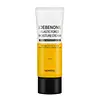What's inside
What's inside
 Key Ingredients
Key Ingredients

 Benefits
Benefits

 Concerns
Concerns

No concerns
 Ingredients Side-by-side
Ingredients Side-by-side

Water
Skin ConditioningGlycerin
HumectantButylene Glycol
HumectantHydrogenated Lecithin
EmulsifyingSucrose
HumectantGlucose
HumectantFructose
HumectantBeta-Glucan
Skin ConditioningHydroxydecyl Ubiquinone
AntioxidantSorbitol
HumectantErythritol
HumectantXanthan Gum
EmulsifyingHydrogenated Polyisobutene
EmollientCaprylic/Capric Triglyceride
MaskingTocopherol
AntioxidantDipotassium Glycyrrhizate
HumectantAllantoin
Skin ConditioningEthylhexylglycerin
Skin ConditioningPropanediol
SolventChamaecyparis Obtusa Branch/Leaf Extract
HumectantWater, Glycerin, Butylene Glycol, Hydrogenated Lecithin, Sucrose, Glucose, Fructose, Beta-Glucan, Hydroxydecyl Ubiquinone, Sorbitol, Erythritol, Xanthan Gum, Hydrogenated Polyisobutene, Caprylic/Capric Triglyceride, Tocopherol, Dipotassium Glycyrrhizate, Allantoin, Ethylhexylglycerin, Propanediol, Chamaecyparis Obtusa Branch/Leaf Extract
Water
Skin ConditioningButylene Glycol
HumectantHydrogenated Polyisobutene
EmollientDimethicone
EmollientGlycerin
HumectantPoly 1,2-Butanediol-6 Propylene Glycol
SolventHydroxyacetophenone
AntioxidantPEG-400
Emulsion StabilisingAmmonium Acryloyldimethyltaurate/Vp Copolymer
Hydrogenated Lecithin
EmulsifyingPanthenol
Skin ConditioningPhytosteryl/Octyldodecyl Lauroyl Glutamate
Skin ConditioningCarbomer
Emulsion StabilisingAllantoin
Skin ConditioningPCA
HumectantHydroxyethyl Acrylate/Sodium Acryloyldimethyl Taurate Copolymer
Emulsion StabilisingSqualane
EmollientCeramide NP
Skin ConditioningCeramide Ns
Skin ConditioningCeramide As
Skin ConditioningCeramide EOP
Skin ConditioningCeramide AP
Skin ConditioningSodium Hyaluronate
HumectantHydrolyzed Collagen
EmollientCentella Asiatica Extract
CleansingSodium Hydroxide
BufferingHamamelis Virginiana Extract
AntiseborrhoeicTrehalose
HumectantEctoin
Skin ConditioningSophora Flavescens Root Extract
AntioxidantOpuntia Ficus-Indica Stem Extract
Skin ConditioningOphiopogon Japonicus Root Extract
Skin ConditioningYeast Polysaccharides
Skin ConditioningPentylene Glycol
Skin ConditioningDisodium EDTA
Polysorbate 60
EmulsifyingT-Butyl Alcohol
PerfumingCitrus Aurantium Amara Flower Oil
MaskingSorbitan Isostearate
EmulsifyingCitrus Aurantium Bergamia Fruit Oil
MaskingCitrus Medica Peel Oil
Water, Butylene Glycol, Hydrogenated Polyisobutene, Dimethicone, Glycerin, Poly 1,2-Butanediol-6 Propylene Glycol, Hydroxyacetophenone, PEG-400, Ammonium Acryloyldimethyltaurate/Vp Copolymer, Hydrogenated Lecithin, Panthenol, Phytosteryl/Octyldodecyl Lauroyl Glutamate, Carbomer, Allantoin, PCA, Hydroxyethyl Acrylate/Sodium Acryloyldimethyl Taurate Copolymer, Squalane, Ceramide NP, Ceramide Ns, Ceramide As, Ceramide EOP, Ceramide AP, Sodium Hyaluronate, Hydrolyzed Collagen, Centella Asiatica Extract, Sodium Hydroxide, Hamamelis Virginiana Extract, Trehalose, Ectoin, Sophora Flavescens Root Extract, Opuntia Ficus-Indica Stem Extract, Ophiopogon Japonicus Root Extract, Yeast Polysaccharides, Pentylene Glycol, Disodium EDTA, Polysorbate 60, T-Butyl Alcohol, Citrus Aurantium Amara Flower Oil, Sorbitan Isostearate, Citrus Aurantium Bergamia Fruit Oil, Citrus Medica Peel Oil
 Reviews
Reviews

Ingredients Explained
These ingredients are found in both products.
Ingredients higher up in an ingredient list are typically present in a larger amount.
Allantoin is a soothing ingredient known for its protective and moisturizingg properties. Because of this, it is often added to products with strong active ingredients.
Studies show higher concentrations of this ingredient can promote wound healing.
Though it can be derived from the comfrey plant, allantoin is produced synthetically for cosmetic products to ensure purity.
Learn more about AllantoinButylene Glycol (or BG) is used within cosmetic products for a few different reasons:
Overall, Butylene Glycol is a safe and well-rounded ingredient that works well with other ingredients.
Though this ingredient works well with most skin types, some people with sensitive skin may experience a reaction such as allergic rashes, closed comedones, or itchiness.
Learn more about Butylene GlycolGlycerin is already naturally found in your skin. It helps moisturize and protect your skin.
A study from 2016 found glycerin to be more effective as a humectant than AHAs and hyaluronic acid.
As a humectant, it helps the skin stay hydrated by pulling moisture to your skin. The low molecular weight of glycerin allows it to pull moisture into the deeper layers of your skin.
Hydrated skin improves your skin barrier; Your skin barrier helps protect against irritants and bacteria.
Glycerin has also been found to have antimicrobial and antiviral properties. Due to these properties, glycerin is often used in wound and burn treatments.
In cosmetics, glycerin is usually derived from plants such as soybean or palm. However, it can also be sourced from animals, such as tallow or animal fat.
This ingredient is organic, colorless, odorless, and non-toxic.
Glycerin is the name for this ingredient in American English. British English uses Glycerol/Glycerine.
Learn more about GlycerinHydrogenated Lecithin is created from the hydrogenation of lecithin (a group of phospholipids). Hydrogenation is a chemical reaction between hydrogen and another element.
This ingredient is an emollient and emulsifier. As an emollient, it helps soften skin by trapping moisture within. As an emulsifier, it prevents oil and water ingredients from separating.
Hydrogenated Polyisobutene is a synthetic polymer. Polymers are compounds with high molecular weight. Hydrogenated Polyisobutene is an emollient and texture enhancer.
In one study, Hydrogenated Polyisobutene showed better skin hydration levels than Caprylic/Capric Triglyceride. As an emollient, it helps keep your skin soft and hydrated by trapping moisture in.
Hydrogenated Polyisobutene is often used as a mineral oil replacement.
Learn more about Hydrogenated PolyisobuteneWater. It's the most common cosmetic ingredient of all. You'll usually see it at the top of ingredient lists, meaning that it makes up the largest part of the product.
So why is it so popular? Water most often acts as a solvent - this means that it helps dissolve other ingredients into the formulation.
You'll also recognize water as that liquid we all need to stay alive. If you see this, drink a glass of water. Stay hydrated!
Learn more about Water